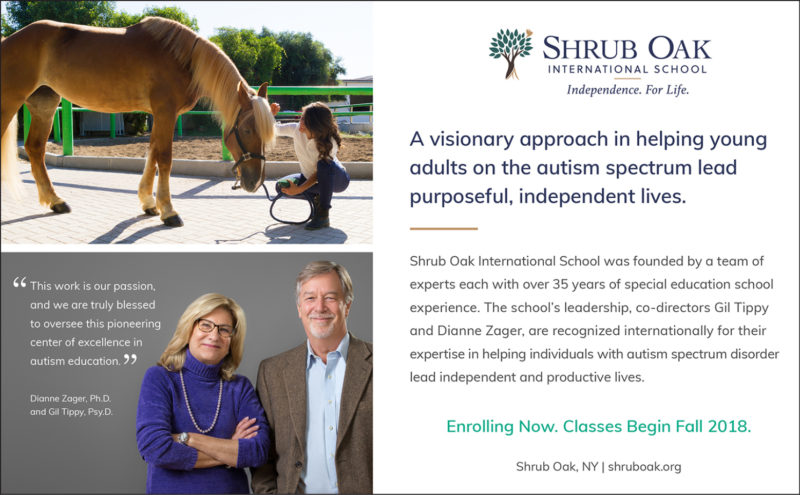Unemployment rates for people with disabilities currently are hovering around 80%, with even higher rates for individuals with autism spectrum disorder (Bureau of Labor Statistics, 2017). Over the past several decades, employment outcomes for students with autism have remained consistently poor (Skaff, Kemp, McGovern, & Fantacone, 2016). It is clear that special educators need to do a better job preparing students for the transition to employment. The good news is that transition programs have emerged in schools across the US; the not-so-good news is that these programs rarely lead to jobs upon graduation, presenting the need for employment intervention programs (Agran, Hughes, Thoma, Scott, 2016).

Dianne Zager, PhD, Head of School
The Workforce Innovation and Opportunity Act (WIOA, 2014) emphasizes the need to support students as they transition to employment. Individualized career pathways, including career awareness, service learning, job shadowing, internships, and even paid employment (Kittleman, Bromley, & Mazotti, 2016) have been suggested as possible means to improve outcomes. The WIOA points to competitive integrated employment as the desired employment outcome for individuals with disabilities. If we are to meet the requirements of this Act, schools need to do a far better job preparing students for meaningful careers.
Whether students with autism choose to pursue higher education or wish to begin a job upon graduation, they should be afforded experiences to explore varied career options (Cease-Cook, Fowler, & Test, 2015). Just as math and English are considered indispensable components of a good education program, teachers need to be trained to provide effective evidence-based instruction in transition and career development.
The Employment Intervention Model
The first step in improving employment outcomes for students with autism is to develop a meaningful career development curriculum that is grounded in evidence-based principles and practices. The Employment Intervention (EI) curriculum developed at Shrub Oak International School serves as an example of multi-faceted transition programming that is research-informed and data-driven. The EI curriculum is built upon Universal Design for Transition (UDT) principles and the Self-Determined Learning Model of Instruction (SDLMI). Universal Design for Transition instruction adapts learning activities rather than trying to change the individual. The UDT framework, developed by Thoma (2009) offers strength-based instruction that is designed to meet individual learning preferences, interests, and characteristics. UDT is a research-based approach that has been used with success to teach job skills and work-related behaviors to support students with autism in inclusive transition programs (Zager, Alpern, Mckeon, & Mulvey, 2013).
An example of UDT might involve a student who has a career aspiration to work in a bakery. The student will need skills in measuring liquids, powders, and/or solids (math and science), use of timers to monitor baking time (math), reading skills to follow recipes (literacy), and social communication competence to interact with co-workers and customers. These relevant academic and social skills, which are based on the student’s stated interests, can be taught concomitantly in the classroom, around the school, and at worksites in the local community. The EI model is ideally suited for use with individuals with autism because its flexibility and wide range of presentation styles can accommodate diverse information processing styles to increase opportunities for engagement in learning activities, as well as to enhance fluency and generalization of skills. In short, EI is a student-centered, strength-based, data-driven model with collaboration among educators, employers, and family at its core (Emmons & Zager, 2018).
UDT by itself would constitute a major improvement in transition education. Combined with the Self-Determined Learning Instructional Model, the likelihood of successful student outcomes is exponentially increased (Wehmeyer, Palmer, Lee, Williams-Diehm, & Shogren, 2011). Self-determination includes concepts of independence, freedom of choice, self-direction, and responsibility. Skills that comprise self-determination competence include choice making, decision making, problem solving, goal setting, risk taking with safety, self-regulation, self-instruction, self-advocacy, self-awareness, and self-knowledge. Students who are self-determined are more likely to become employed and live independently.
The Shrub Oak EI model places heavy emphasis on self-determination, using the evidence-based Self-Determined Learning Model of Instruction (SDLMI), developed by Wehmeyer et al. (2011). By focusing on building self-determination competence while providing employment intervention, teachers can help students acquire skills, behaviors, and attitudes that are necessary for employment success. SDLMI is a self-directed process using a problem-solving strategy in which students learn to identify and set goals, develop action plans to achieve goals, and self-monitor progress toward goals. The SDLMI has been shown to increase attainment of academic and transition goals and enhance self-determination competence.
Research studies have been conducted on the UDT and SDLMI approaches with positive findings. The Shrub Oak curriculum has been designed to expand UDT in combination with SDLMI to create a new school-wide system to improve employment outcomes. To ensure the program’s success, EI uses continuous monitoring of student progress.
In any discussion about employment intervention for students with autism, we need to consider technology as an important support for students at worksites. Technology is incorporated into the Shrub Oak EI system in several ways. Through assistive technology students can be enabled to actively participate in community jobs from the onset of their employment exploration experiences. To promote skill acquisition and development of work-related behaviors, video modeling is used to provide continuous feedback and instructional support. Finally, when students graduate, they should have employment portfolios, which contain vocational assessment information about their strengths, abilities, and individual characteristics, including video snapshots of themselves working at varied worksites.
Strategies for employment intervention discussed in this article have been shown to be effective in enhancing employment outcomes for students with autism. Comments and thoughts from ASN readers about these ideas are invited and should be sent to Dr. Dianne Zager at dzager@shruboak.org. For additional information go to https://shruboak.org/.
References
Agran, M., Hughes, C., Thoma, C.A., & Scott, L.A. (2016). Employment social skills: What skills are really valued? Career Development and Transition for Exceptional Individuals, 39(2), 111-120.
Bureau of Labor Statistics, (2017, June 21). News release: Persons with a Disability: Labor Force Characteristics Summary. Washington, DC: Bureau of Labor Statistics, U.S. Department of Labor. Retrieved from https://www.bls.gov/news.release/disabl.nr0.htm
Cease-Cook, J., Fowler, C.H., & Test, D. W. (2015) Strategies for creating work-based learning experiences in schools for secondary students with disabilities. Teaching Exceptional Children, 47, 352-358.
Emmons, C.L., & Zager, D. (2018). Increasing collaboration efficacy to improve educational programming for students with autism. Focus on Autism and Other Developmental Disabilities, 33(2), 120-128.
Kittelman, A., Bromley, K.W., & Mazotti, V.L. (2016) Functional behavioral assessments and behavior support plans for work-based learning. Career Development and Transition for Exceptional Individuals, 39(2), 121-127.
Roux, A. M., Shattuck, P. T., Rast, J.E., Anderson, K. A. (2017). National autism indicators report: Developmental disability services and outcomes in adulthood. Life Course Outcomes Research Program. Drexel Autism Institute, Drexel University.
Shattuck, P.T., Orsmond, G.I., Wagner, M., & Cooper, B.P. (2011) Participation in Social Activities among Adolescents with an Autism Spectrum Disorder. Public Library of Science (PLOS) ONE, 6(11). Retrieved from https://doi.org/10.1371/journal.pone.0027176.
Skaff, L.F., Kemp, J.N., McGovern, L.A.S., Fantacone, J.M. (2016). Educator and parent views of individualized learning plans for students with disabilities. Career Development and Transition for Exceptional Individuals, 39(2), 68-79.
Thoma, C.A., Bartholomew, C.C., & Scott, L.A. (2009). Universal design for transition: A roadmap for planning and instruction. Baltimore: Paul H. Brookes Publishing Co.
Wehmeyer, M.L., Palmer, S.B., Lee, Y., Williams-Diehm, K., & Shogren, K.A. (2011). A randomized-trial evaluation of the effect of Whose Future is it Anyway? on self-determination. Career Development for Exceptional Individuals, 34(1), 45-56.
Workforce Innovation and Opportunity Act, 29 USC §3101-3361 (2014).
Zager, D., Alpern, C., Mckeon,, & Mulvey, M. (2013). Educating college students with autism spectrum disorders. London: Routledge/Taylor & Francis.






